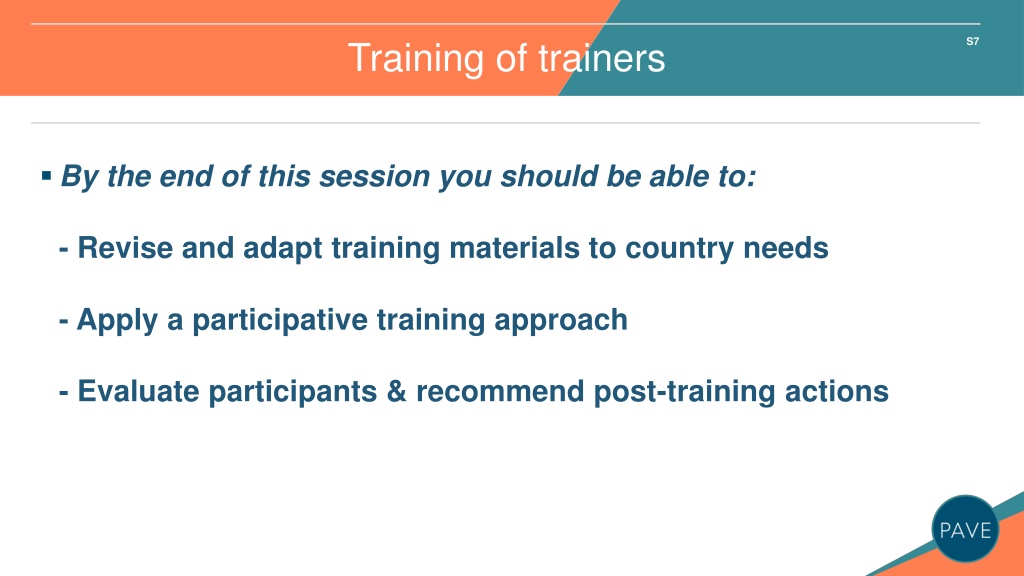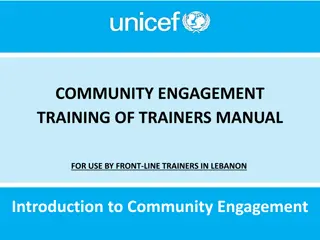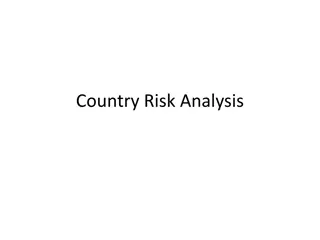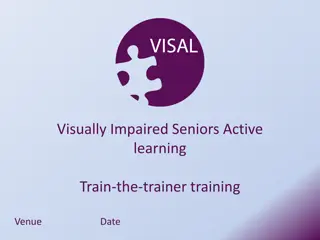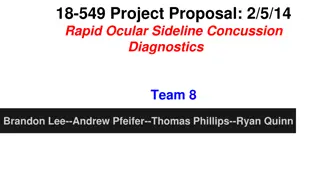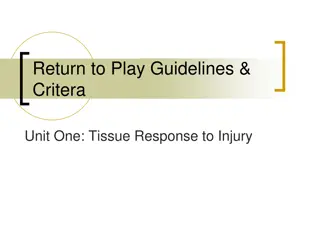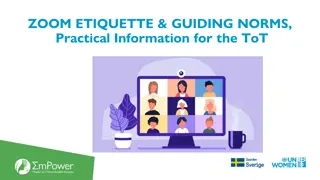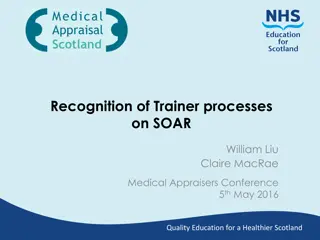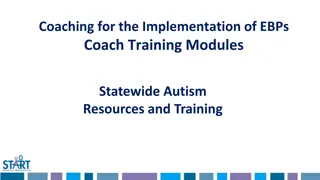Training of Trainers: Adapting Training Materials for Country-specific Needs
To enhance training effectiveness, this session focuses on revising and adapting materials to suit country contexts, adopting participative approaches, and evaluating participants for post-training actions. Learn about tailoring training content for different health systems and cadre of professionals, ensuring alignment with current treatment practices and patient pathways. Guidance on introducing new tools and conducting role-play scenarios is provided to enhance learning outcomes.
Download Presentation

Please find below an Image/Link to download the presentation.
The content on the website is provided AS IS for your information and personal use only. It may not be sold, licensed, or shared on other websites without obtaining consent from the author. Download presentation by click this link. If you encounter any issues during the download, it is possible that the publisher has removed the file from their server.
E N D
Presentation Transcript
Training of trainers S7 By the end of this session you should be able to: - Revise and adapt training materials to country needs - Apply a participative training approach - Evaluate participants & recommend post-training actions
Training preparation Adapting training materials 1 S7 Adapting training materials Country treatment strategy or proposed strategy Training sessions have been tailored to two scenarios: Introduction of the quantitative G6PD test used with primaquine and, Both the Qn-G6PD test and Tafenoquine are introduced simultaneously Country context These training materials will have most impact when adapted with and by in-country partners who can provide context specific detail on how the materials should reflect the health system, delivery of training, supervision of Health workers. Messages around adherence to PQ should be tailored to the context in collaboration with Behaviour Change Communication specialists in-country Frameworks for thinking about AHA and clinical management need to be adapted with clinicians from the country using these materials to properly reflect current treatment practice for AHA Specific sessions could be included into broader malaria diagnostic training that is already planned in- country. While materials are currently tailored to different cadre of health workers, these need to be adapted to the health system in-country. 2
Training preparation - Adapting training materials 2 S7 Participant profiles At what level of the health system are new tools being introduced? - What type of health professional being trained? - For what parts of the patient pathway is the health worker responsible? 3
S7 Training preparation - Training sessions Introduction session Session 1: What is Plasmodium vivax malaria & Glucose-6-Phosphate Dehydrogenase (G6PD) deficiency? Session 2.1: How to perform Qn-G6PD test part 1 Theory Session 2 (controls): How to run Qn-G6PD controls_Pt1 Theory Session 2 (venous): How to do the Qn-G6PD test with venous blood_Pt1 Theory Session 2.2: How to perform Qn-G6PD test part 2 Practical Session 3.1: How to treat P. vivax malaria parts 1 & 2 (Primaquine) & mini-scenarios Session 3.2: How to treat P. vivax malaria parts 1 & 2 (Primaquine and Tafenoquine) Session 4: Risk minimization & patient counselling Session 5: Identification & reporting Acute Haemolytic Anaemia (AHA) Session 6: Introducing new tools into your facility & role-play scenarios Wrap up session 4
S7 Example agendas [Country] Country treatment strategy NMCP in the country of Meath aim to roll out Quantitative-G6PD + PQ14 to community level Roll out of Quantitative-G6PD starting at higher level facilities and extending to community level once access strategy identified through Feasibility Studies (FS) Country context Variable G6PD deficiency reported (8 31%) Clustered vivax caseload in specific sub-national (adm 3) areas classified by NMCP as hotspots Overlap between suspected high prevalence G6PDd areas + vivax hotspots Programme externally funded through Global Fund with budget allocated for Qn-G6PD analyzers and test devices 5
S7 Example agendas [Country] Participant profile & training needs Participant profile Role in Px pathway Suggestion training session Hospital or higher level facility GP, infectious disease experts or doctors Interprets G6PD results to prescribe malaria treatment, counsels patient on treatment course 8 sessions: Introduction, S1, S2.1, S3.1, S4, S5, S6, wrap-up session Nurses at national or sub-national hospitals (facilities with in-patient care) Sometimes tests patients for malaria & G6PD. Mainly interprets G6PD results to prescribe malaria treatment, counsels patient on treatment course 8 sessions: Introduction, S1, S2.1, S3.1, S4, S5, S6, wrap-up session Laboratory technicians Tests patients for malaria & G6PD. Refers patient to doctor or nurse for treatment 6 sessions: Introduction, S1, S2.1 & S2.2 including venous and controls), S6, wrap-up session Lower level health facilities nursing aids, midwives (primary health care facilities) + community volunteers Often tests patients for malaria & G6PD, interprets test results, prescribes and administers treatment for malaria 10 sessions: Introduction, S1, S2.1 & S2.2, S3.1 & S3.2, S4, S5, S6, wrap-up session 6
S7 Example agenda [Country] Training agenda 1: Laboratory technicians Session # Session title Introductions and overview of agenda What is P. vivax malaria & G6PD? Quantitative-G6PD part 1 Theory (including venous blood & controls) Quantitative-G6PD part 2 Practical Introducing new tools in health facilities Wrap-up session Post-training competency test Total session time (approx.) Time 45 mins 30 mins 45 mins Intro S1 S2.1 90 mins 30 mins 10 mins 45 mins 5 hours S2.2 S6 Wrap Quiz2 7
S7 Example agenda [Country] Training agenda 2: Lower level health facilities Session # Session title Time Introductions and overview of agenda 45 mins Intro Pre-training quiz 45 mins SQ1 What is P. vivax malaria & G6PD? 30 mins S1 Quantitative-G6PD part 1 Theory 45 mins S2.1 Quantitative-G6PD part 2 Practical (including competency testing) 120 mins S2.2 Treatment with PQ 60 mins S3.1 Mini-scenarios & role plays 45 mins S3.2 Risk minimization & patient counselling 30 mins S4 Identification and reporting of AHA 45 mins S5 Introducing new tools in health facilities & role-plays 70 mins S6 Wrap-up session 10 mins Wrap Post-training evaluation 45 mins Quiz2 Total session time (approx.) 2 days 8
S7 Training approach Participative training The overall training approach should be one that encourages active learning and participation. Room layout should facilitate participation, either having people sit in clusters or groups or in a large circle (if writing seats are available). Below are guidelines that can be followed to ensure a participative approach is followed: Reiterate throughout the training that participants should feel free to ask questions and share their experiences at any time Always treat all the participants with respect irrespective of culture, age, or gender. Secure and respect confidentiality to allow facilitators and participants discuss issues without fear of negative consequences Seek expert opinion of both facilitators and participants throughout training Commit to critical appraisal of your activities and respect of criticism to make the fairness of your decisions evident From the very beginning determine how facilitators and invited specialists will cooperate and voice their opinions both positive and negative and how to keep each other within the context of the programme. 9
S7 Training preparation - Training Training facilitation Identification of trainers - Trainers or facilitators should be experts from the National programme and those from related departments implicated in the use of the new tools - Experts from other departments should include; the department that oversees medical services/hospitals, FDA/pharmacovigilance units and surveillance units Trainer preparation - Once the core group of trainers or facilitators are identified, they should be included in the adaptation of training materials - Trainers should read through all generic materials, including facilitators notes under each slide - Practice sessions with the G6PD analyzers should be organised before full training begin to give facilitators the opportunity to familiarise themselves with the analyzers, test devices, controls alongside training materials - Trainers should also practice role-play set up and read-through and understand the mini-scenarios Trainer roles - Trainers should support each other in time-keeping during different sessions - Trainers that are not presenting should take notes during the training when participants are providing feedback and participating in training sessions - All trainers should contribute to the training report, ensuring that notes taken during sessions are included 10
S7 Training preparation slide & session structures Slides & slide notes Trainers should go through slides in detail prior to training noting where changes need to be made to their context Particular attention should be given to the slide notes in which there is an overview of the timing for each session, prompts to encourage participation and background detail on the content of the slide as well as instructions for role plays and groupwork Practical sessions Trainers need to ensure materials for practical sessions are ready and set up ahead of training. Materials required for each session are listed in the slide notes for practical's Role-plays & mini-scenarios Trainers need to read through mini-scenarios to ensure they are adapted to their country context Role-play materials should be prepared in advance of the training. Trainers should discuss how they will share learnings from the role-plays 11
S7 Ensuring training quality Numbers of participants & ratio of trainers: participants Level of health system Type of health professional Max # of participants Ratio of trainers to participants Hospital level Medical physicians, general practitioners, infectious disease specialists 35 1:15 Sub-national level in- patient facilities Nurses, nurse practitioners, laboratory technicians 30 1:8 or 1:10 Primary health care facilities Nursing assistants 25 1:7 Community level Volunteers 20 1:5 Ensure an adequate ratio of G6PD analysers to trainees: 2 to 4 trainees per device 12
Ensuring training quality G6PD competency evaluations S7 G6PD competency evaluation should be carried out for every participant undertaking the G6PD practical sessions Competency testing is best undertaken at the end of practical sessions by 1-2 trainers Focus the competency assessment on the practical aspects of G6PD testing. Cover the theoretical aspects such as interpretation in the pre/post test. The competency assessment should be completed for each participant If participants score low or medium marks in the competency assessment, further training should be arranged immediately before G6PD analyzers are distributed to their facilities 13
S7 Ensuring training quality Participants with low post-training quiz and/or G6PD device competency scores - No new tools should be introduced into facilities where health workers have scored low on post-training quizzes or tests - Post-training quiz and G6PD competency scores should be marked immediately after training has taken place - The pass mark for this training is 85% - For participants who scored above 85 99% trainers should go through their evaluations to highlight correct answers - For participants who score <85% retraining should be re-organised within 4 weeks of initial training. 14
S7 Training report structure The following should be captured in your training report 1. Participant profiles In-service training Recent refresher training on malaria case management Number of years of experience since in-service training Level of health facility at which participants work Job responsibilities of participants 2. Number of trainers 3. Participative sessions & participant FAQs Notes from any participative sessions where there was feedback on questions asked by trainers Any questions that participants frequently asked during the training session 4. Pre & post evaluation results Highlighting any questions that many participants failed to answer correctly Including a table with participants by marking category With an action plan as to post-evaluation follow up for poor and intermediate scored participants 15
S7 Training feedback Post-training reports could also help us to improve these training materials. Where possible, please provide feedback on the training materials and discussions or challenges that participants faced during training. Feedback can be provided to: XXXXXXXX 16
